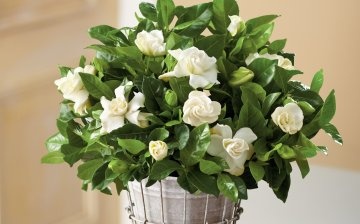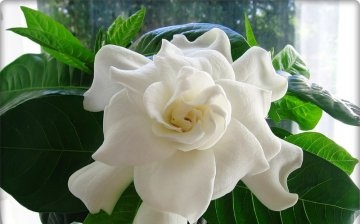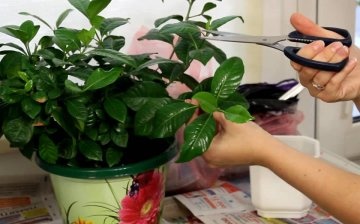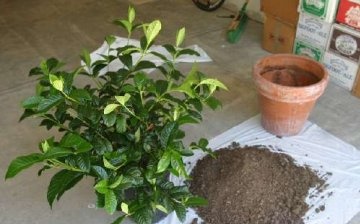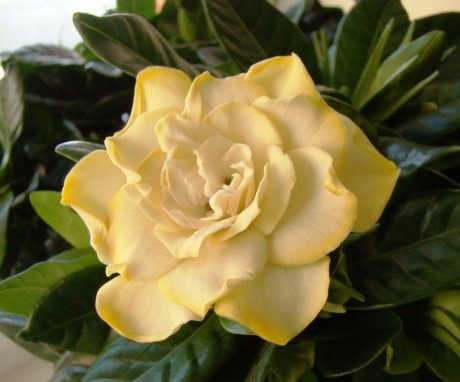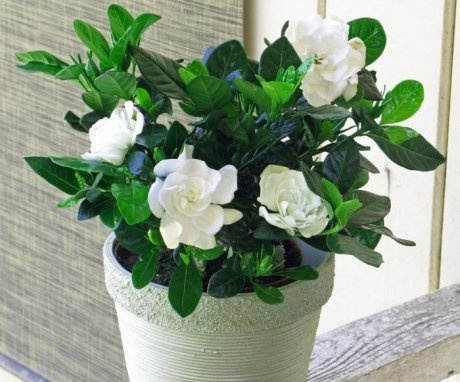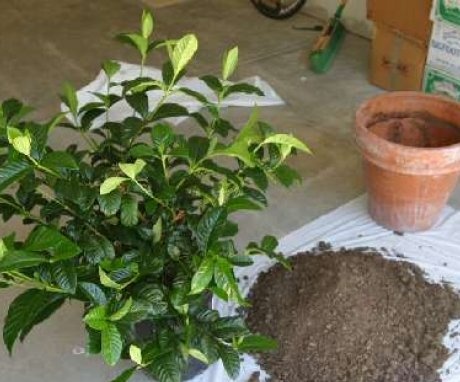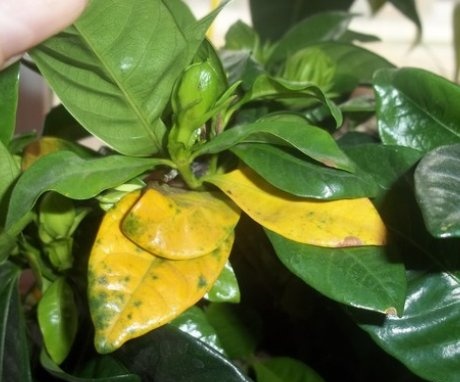Gardenia jasmine - Chinese beauty on the windowsill
An evergreen gardenia bush with white fragrant flowers, discovered in the subtropics, has long won the recognition of indoor floriculture lovers. Everyone would like to have such a plant at home, but it is very capricious, delicate.
In the 13th century, the American botanist Alexander Garden described small trees, on the branches of which similar to jasmine flowers that amaze with a delightful aroma. Over time, gardenia moved to window sills from the tropics of Asia, Africa to the northern regions.
Content:
- Description of gardenia
- Popular varieties of tropical shrubs
- Reproduction and planting of indoor flower
- Tips for caring for a capricious gardenia
- Transplant tips
- How to avoid diseases and save a flower from pests
Description of gardenia
Jasmine gardenias belonging to the Madder family sometimes reach two meters in height in nature, and those growing in houses - eighty centimeters. Strong shoots are covered with small, paired leaves of a leathery structure with light green and dark green tones.
From July to October, the ends of the branches of the bush are covered with beautifully shaped flowers that have different colors from snow-white, yellowish to orange or pinkish. Their gardenia rivals in aroma and beauty roses.
The older the plant, the more often and more abundantly it blooms.
In place of flown flowers, a fruit remains, which looks like a cylinder or a small pear... The fruits are of value for medicine. They have the ability to stop bleeding, relieve inflammation in mastitis, stomatitis. The crocin glycoside found in them is used in choleretic agents. It is the external beauty of gardenia, the exquisite smell of its flowers that makes a person admire the plant, growing it in a flower pot.
Popular varieties of tropical shrubs
Jasmine gardenia is chosen for reproduction because it looks like a beautiful rose, but has greater tenderness, sophistication. There are several interesting varieties of the famous shrub:
- The regal gardenia can be recognized by its creamy colors. It can be grown in greenhouses and indoors.
- A plant of the Kula variety is called a golden flower, reaching two meters and growing in gardens.
- Chuck Hayes' fragrant elephant-colored flowers appear in early summer and bloom throughout the entire period, without fear of cold weather.
- Variegated variegated leaves of Variegata attract attention with transitions from green to cream. The shrub grows very slowly, so it is suitable for growing in pots.
- The perfect shape of Amy flowers against a background of dark green foliage is amazing. Twice a year, the plant is covered with double inflorescences with a diameter of twelve centimeters.
- The Belmont gardenia is resistant to diseases and cold, the flowers of which are densely doubled and have a strong aroma.
Each variety of jasmine gardenia is good in its own way, interesting in shape, tone of flowers and foliage.
Reproduction and planting of indoor flower
It is better to grow an evergreen shrub from cuttings that are harvested on their own. Start to cut branches for propagation after the end bloom... Cuttings are prepared in spring or late summer from those shoots that are already partially lignified. Cut them off from the top of the tree. The cuttings should be with a heel, and in order to increase their speed and chances of rooting, it is necessary to treat the branches with a growth stimulant of the Kornevin type.
After that, they are immersed in a weak solution of potassium permanganate for several minutes. Now you can plant the prepared shoots in containers with soil consisting of sand and peat. Before the roots appear, the pots with cuttings will be in a room with an air temperature of at least twenty-five degrees above zero.
They need greenhouse conditions, so the containers with planting material are covered with plastic wrap, regularly removing it for ventilation. At this point, special attention is paid to the moisture content of the soil in the pots. Comfortable conditions will allow the cuttings to give roots in about a month.
Planting a gardenia begins during a dormant period, observing some rules:
- The plant needs a substrate of an acidic, loose character. For this, soil is added to the pot, which is prepared for the bush, consisting of such components as peat, sand, coniferous and garden soil, taken in equal quantities.
- The size of the container for the flower should correspond to the volume of the root. gardenias.
- It is necessary to place the plant in the place of the house where the light is brightest, but without direct sunlight in order to avoid burns. Better if it is a window of the west or southwest.
- Since in nature, the jasmine gardenia prefers the climate of the tropics and subtropics, the humidity in the room plays an important role for it. A pallet with wet expanded clay or moss will help create a tropical atmosphere. In case of heat, spraying will not harm the plant. But here you must try not to get on the flowers, as drops of liquid will spoil them. A warm shower for a gardenia is a true blessing.
- The air temperature for the bush must be high, without a sharp drop. The optimal temperature is 24-18 degrees Celsius, in winter it can be slightly lower.
Fulfilling the conditions for the growth of gardenia will help maintain its vitality for a long time.
Tips for caring for a capricious gardenia
During the growing season, the houseplant should be given special attention. It consists in proper watering. The top layer in a pot with a plant should always be wet, drying out is unacceptable. In winter, watering is moderate, twice a week. At the end of March, three months before flowering, it is reduced almost completely, it will be enough two times in ten days. Then the buds will develop correctly. Water for irrigation is used warm, two degrees above the air temperature, well settled. You can add a few drops of citric acid to it, which will increase the acidity of the soil.
It is better to feed the gardenia twice a month while the plant is young.
Adults need fertilization every week during the growing season. Fit like organicand mineral types of feeding, but not containing calcium. Useful peat-humic substrates, mineral concentrates of the Vito type.
After the gardenia bushes have faded, they are pruned. During the procedure, weak shoots are removed, those that thicken the bush. The tip of the young shoots is pinched, which stimulates the formation of flower buds. Proper care is the main thing for the indoor florist who grows the jasmine gardenia.
Transplant tips
While the young gardenia is growing, it is transplanted every year in the spring, although a period of active growth - summer is also suitable. Usually, a transplant is necessary due to the fact that the inside of the pot is all braided with roots or the flower has stopped growing. Then they select a larger container, add drainage and soil to it.The main methods of transplanting include careful handling without injury. root system.
An adult gardenia should also be carefully transplanted - once every two or three years.
It is undesirable to rinse the roots during the procedure, as you can wash off the beneficial fungi and bacteria necessary for the full development of gardenia. This will only have to be done if the roots are rotten or sour.
The plant in the new pot should not sit deeper than in the old one. Deepening the base of the stem - one to two centimeters below the top edge of the container. Then the soil must be poured and lightly tamped. After transplanting, the plant is watered abundantly.
How to avoid diseases and save a flower from pests
Plant diseases occur mainly from improper care and poor conditions in which the flower lives. Waterlogged soil, low temperatures lead to blackening and leaf fall. Too dry air causes the death of the buds. Hard water used for irrigation causes yellow foliage.
But pests are attracted by the aroma of gardenia:
- Colonies aphids attack the plant, gradually destroying it. To combat it, not only insecticides are used, but also a solution of laundry soap. The pest can be washed off with warm running water, destroyed with tobacco broth prepared from shag waste. They insist on it for a day, diluting two hundred grams of raw materials in half a glass of water.
- From the red spider mite, which destroys all parts of the indoor flower, get rid of a drug such as Decis or green soap. Onion peel infused in warm water also effectively fights the parasite. A solution is prepared from twenty grams of husk per liter of water. It is necessary to spray the bushes three times with an interval of ten days.
- The scale insect gardenia can cause great harm. It is possible to get rid of the pest by wiping the leaves with soapy water or by treating them with insecticidal preparations.
There will be no deviations in the development of the plant if you are attentive to the green pet.
More information can be found in the video:



